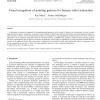Free Online Productivity Tools
i2Speak
i2Symbol
i2OCR
iTex2Img
iWeb2Print
iWeb2Shot
i2Type
iPdf2Split
iPdf2Merge
i2Bopomofo
i2Arabic
i2Style
i2Image
i2PDF
iLatex2Rtf
Sci2ools
IVC
2007
2007
Visual recognition of pointing gestures for human-robot interaction
In this paper, we present an approach for recognizing pointing gestures in the context of human–robot interaction. In order to obtain input features for gesture recognition, we perform visual tracking of head, hands and head orientation. Given the images provided by a calibrated stereo camera, color and disparity information are integrated into a multi-hypothesis tracking framework in order to find the 3D-positions of the respective body parts. Based on the hands’ motion, an HMM-based classifier is trained to detect pointing gestures. We show experimentally that the gesture recognition performance can be improved significantly by using information about head orientation as an additional feature. Our system aims at applications in the field of human–robot interaction, where it is important to do run-on recognition in real-time, to allow for robot egomotion and not to rely on manual initialization. Ó 2006 Elsevier B.V. All rights reserved.
Related Content
| Added | 15 Dec 2010 |
| Updated | 15 Dec 2010 |
| Type | Journal |
| Year | 2007 |
| Where | IVC |
| Authors | Kai Nickel, Rainer Stiefelhagen |
Comments (0)

